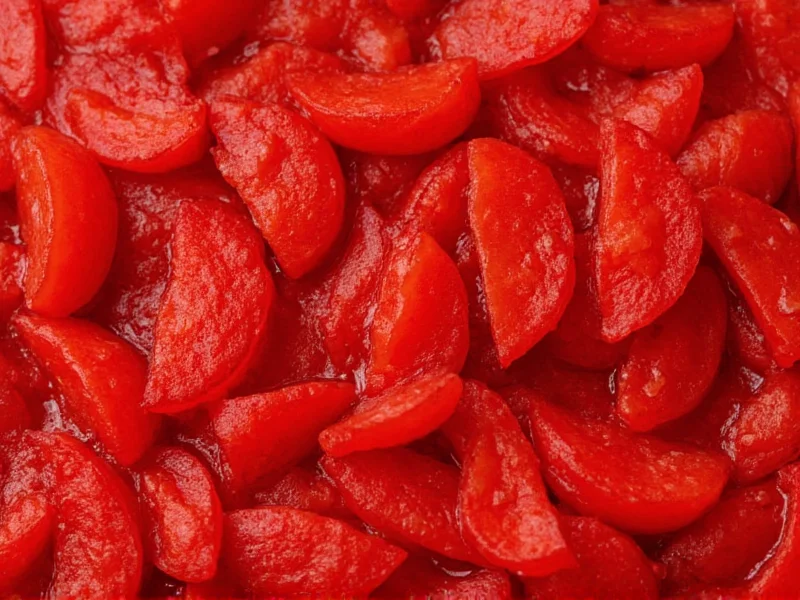Understanding what gives chamoy its distinctive taste requires examining each component that contributes to this beloved Mexican condiment. Chamoy's complex flavor profile—simultaneously sweet, sour, spicy, and savory—comes from a careful balance of specific ingredients that have evolved through generations of Mexican culinary tradition.
The Core Ingredients of Authentic Chamoy
While regional variations exist across Mexico, authentic chamoy consistently features these foundational elements:
| Ingredient Category | Specific Components | Flavor Contribution |
|---|---|---|
| Fruit Base | Apricots, plums, mangos, or prunes | Natural sweetness and tangy foundation |
| Brine Solution | Vinegar, salt, water | Preservation and sour tang |
| Chili Components | Chamoy chilies, guajillo, or arbol peppers | Heat and depth of flavor |
| Flavor Enhancers | Tamarind, lime juice, sugar | Complex sour-sweet balance |
Traditional Preparation Process
The authentic method of making chamoy follows a multi-stage process that transforms simple ingredients into a complex condiment. First, dried fruits undergo a pickling process in a salt-vinegar solution, which preserves them while developing their characteristic tang. This initial brining stage typically lasts several weeks.
After the fruits have properly pickled, they're blended with chili peppers, additional vinegar, and sweeteners to create the final sauce. Some traditional recipes include a step where the fruits are first dried in the sun before pickling, which concentrates their natural sugars and creates a deeper flavor profile.
Regional Variations Across Mexico
Mexican chamoy ingredients vary significantly by region, reflecting local agricultural products and cultural influences. In Oaxaca, chamoy often features native chilhuacle peppers and local fruits, while northern versions might incorporate different chili varieties. The Pacific coast versions frequently include tamarind for additional sourness, creating what's known as "chamoy tamarindo."
Understanding these regional differences helps explain why you might encounter variations when exploring traditional chamoy recipes from different parts of Mexico. Each region's unique climate, available ingredients, and cultural history contributes to distinctive interpretations of this versatile condiment.
Modern Commercial Adaptations
While traditional homemade chamoy follows the fruit-pickling method, many commercial products use shortcuts that affect both ingredients and flavor. Store-bought chamoy often contains:
- Artificial flavorings instead of real fruit
- Preservatives like sodium benzoate
- Thickeners such as modified food starch
- Artificial colors to achieve the characteristic red hue
- Corn syrup instead of natural sweeteners
These modifications allow for mass production and longer shelf life but often sacrifice the nuanced flavor of traditionally prepared chamoy. When examining commercial chamoy ingredients, look for products that list actual fruit purees rather than "natural flavors" for a more authentic experience.
Chamoy's Unique Flavor Chemistry
The magic of chamoy comes from how its ingredients interact through biochemical processes. The pickling process creates lactic acid fermentation, which develops complex flavors beyond what the individual ingredients provide. The capsaicin in chilies binds with receptors that create the sensation of heat, while the fruit acids (like citric and malic acid) provide the characteristic sourness.
This biochemical interplay explains why chamoy made from different fruits produces distinct flavor experiences. Mango-based chamoy tends to be sweeter and fruitier, while plum-based versions offer deeper, more complex notes. Understanding these chemical interactions helps explain what gives chamoy its distinctive taste that's difficult to replicate with artificial ingredients.
How to Identify Quality Chamoy Products
When shopping for authentic chamoy, check the ingredient list for these markers of quality:
- Fruit listed as the first ingredient (mango, apricot, or plum)
- Natural sweeteners like piloncillo or cane sugar
- Specific chili varieties named (not just "chili powder")
- Absence of artificial colors and flavors
- Shorter ingredient lists typically indicate more traditional preparation
Traditional chamoy should have a complex flavor that evolves on your palate—starting sweet, moving to sour, then spicy, with an underlying umami depth. This progression distinguishes authentic chamoy from simpler sweet-and-spicy sauces that lack the nuanced flavor development of properly prepared chamoy.
Common Misconceptions About Chamoy Ingredients
Several myths persist about what chamoy contains. Contrary to some beliefs, authentic chamoy does not contain:
- MSG (monosodium glutamate) as a primary ingredient
- Artificial cherry flavor (though some commercial versions might)
- Alcohol as a main component
- Meat products (traditional chamoy is vegan)
The confusion often stems from commercial products that use artificial ingredients to mimic traditional flavors more cheaply. Understanding traditional chamoy ingredients helps separate authentic preparations from imitations that lack the depth and complexity of the genuine article.
Using Chamoy in Culinary Applications
Knowing what chamoy is made from helps understand its versatile culinary applications. The balance of sweet, sour, spicy, and savory elements makes it ideal for:
- Enhancing fresh fruit (mango, pineapple, watermelon)
- Creating micheladas and other Mexican cocktails
- Marinating proteins for tacos and grilled dishes
- Adding complexity to dipping sauces
- Flavoring frozen treats like raspados
The specific ingredients in chamoy interact differently with various foods. For example, the acidity cuts through fatty foods, while the sweetness complements fresh fruits. Understanding chamoy sauce composition helps home cooks and chefs use it more effectively in their culinary creations.











 浙公网安备
33010002000092号
浙公网安备
33010002000092号 浙B2-20120091-4
浙B2-20120091-4